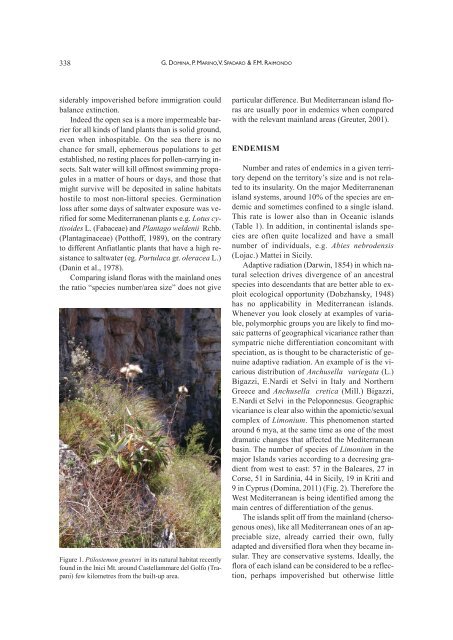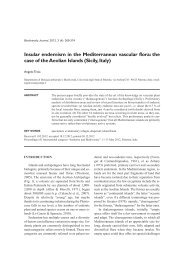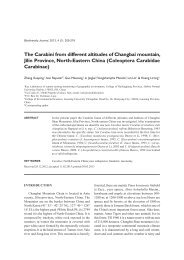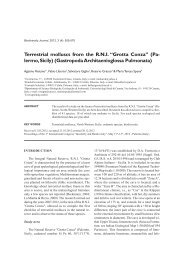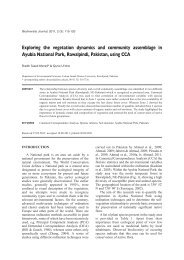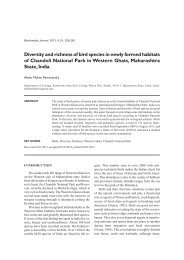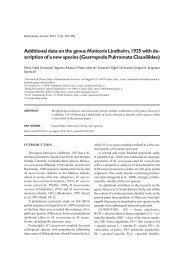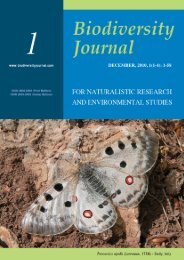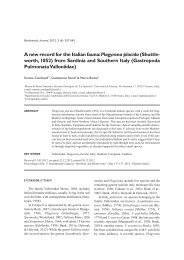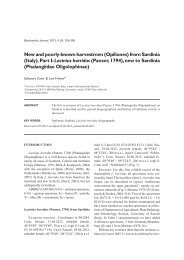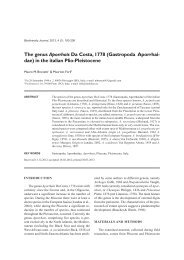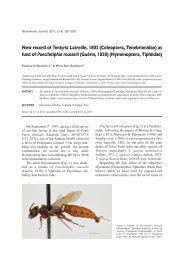Vascular flora evolution in the major Mediterranean islands
Vascular flora evolution in the major Mediterranean islands
Vascular flora evolution in the major Mediterranean islands
Create successful ePaper yourself
Turn your PDF publications into a flip-book with our unique Google optimized e-Paper software.
338G. DOMINA, P. MARINO, V. SPADARO & F.M. RAIMONDOsiderably impoverished before immigration couldbalance ext<strong>in</strong>ction.Indeed <strong>the</strong> open sea is a more impermeable barrierfor all k<strong>in</strong>ds of land plants than is solid ground,even when <strong>in</strong>hospitable. On <strong>the</strong> sea <strong>the</strong>re is nochance for small, ephemerous populations to getestablished, no rest<strong>in</strong>g places for pollen-carry<strong>in</strong>g <strong>in</strong>sects.Salt water will kill offmost swimm<strong>in</strong>g propagules<strong>in</strong> a matter of hours or days, and those thatmight survive will be deposited <strong>in</strong> sal<strong>in</strong>e habitatshostile to most non-littoral species. Germ<strong>in</strong>ationloss after some days of saltwater exposure was verifiedfor some Mediterranenan plants e.g. Lotus cytisoidesL. (Fabaceae) and Plantago weldenii Rchb.(Plantag<strong>in</strong>aceae) (Potthoff, 1989), on <strong>the</strong> contraryto different Anfiatlantic plants that have a high resistanceto saltwater (eg. Portulaca gr. oleracea L.)(Dan<strong>in</strong> et al., 1978).Compar<strong>in</strong>g island <strong>flora</strong>s with <strong>the</strong> ma<strong>in</strong>land ones<strong>the</strong> ratio “species number/area size” does not giveFigure 1. Ptilostemon greuteri <strong>in</strong> its natural habitat recentlyfound <strong>in</strong> <strong>the</strong> Inici Mt. around Castellammare del Golfo (Trapani)few kilometres from <strong>the</strong> built-up area.particular difference. But <strong>Mediterranean</strong> island <strong>flora</strong>sare usually poor <strong>in</strong> endemics when comparedwith <strong>the</strong> relevant ma<strong>in</strong>land areas (Greuter, 2001).ENDEMISMNumber and rates of endemics <strong>in</strong> a given territorydepend on <strong>the</strong> territory’s size and is not relatedto its <strong>in</strong>sularity. On <strong>the</strong> <strong>major</strong> Mediterranenanisland systems, around 10% of <strong>the</strong> species are endemicand sometimes conf<strong>in</strong>ed to a s<strong>in</strong>gle island.This rate is lower also than <strong>in</strong> Oceanic <strong>islands</strong>(Table 1). In addition, <strong>in</strong> cont<strong>in</strong>ental <strong>islands</strong> speciesare often quite localized and have a smallnumber of <strong>in</strong>dividuals, e.g. Abies nebrodensis(Lojac.) Mattei <strong>in</strong> Sicily.Adaptive radiation (Darw<strong>in</strong>, 1854) <strong>in</strong> which naturalselection drives divergence of an ancestralspecies <strong>in</strong>to descendants that are better able to exploitecological opportunity (Dobzhansky, 1948)has no applicability <strong>in</strong> <strong>Mediterranean</strong> <strong>islands</strong>.Whenever you look closely at examples of variable,polymorphic groups you are likely to f<strong>in</strong>d mosaicpatterns of geographical vicariance ra<strong>the</strong>r thansympatric niche differentiation concomitant withspeciation, as is thought to be characteristic of genu<strong>in</strong>eadaptive radiation. An example of is <strong>the</strong> vicariousdistribution of Anchusella variegata (L.)Bigazzi, E.Nardi et Selvi <strong>in</strong> Italy and Nor<strong>the</strong>rnGreece and Anchusella cretica (Mill.) Bigazzi,E.Nardi et Selvi <strong>in</strong> <strong>the</strong> Peloponnesus. Geographicvicariance is clear also with<strong>in</strong> <strong>the</strong> apomictic/sexualcomplex of Limonium. This phenomenon startedaround 6 mya, at <strong>the</strong> same time as one of <strong>the</strong> mostdramatic changes that affected <strong>the</strong> <strong>Mediterranean</strong>bas<strong>in</strong>. The number of species of Limonium <strong>in</strong> <strong>the</strong><strong>major</strong> Islands varies accord<strong>in</strong>g to a decres<strong>in</strong>g gradientfrom west to east: 57 <strong>in</strong> <strong>the</strong> Baleares, 27 <strong>in</strong>Corse, 51 <strong>in</strong> Sard<strong>in</strong>ia, 44 <strong>in</strong> Sicily, 19 <strong>in</strong> Kriti and9 <strong>in</strong> Cyprus (Dom<strong>in</strong>a, 2011) (Fig. 2). Therefore <strong>the</strong>West <strong>Mediterranean</strong> is be<strong>in</strong>g identified among <strong>the</strong>ma<strong>in</strong> centres of differentiation of <strong>the</strong> genus.The <strong>islands</strong> split off from <strong>the</strong> ma<strong>in</strong>land (chersogenousones), like all <strong>Mediterranean</strong> ones of an appreciablesize, already carried <strong>the</strong>ir own, fullyadapted and diversified <strong>flora</strong> when <strong>the</strong>y became <strong>in</strong>sular.They are conservative systems. Ideally, <strong>the</strong><strong>flora</strong> of each island can be considered to be a reflection,perhaps impoverished but o<strong>the</strong>rwise little


